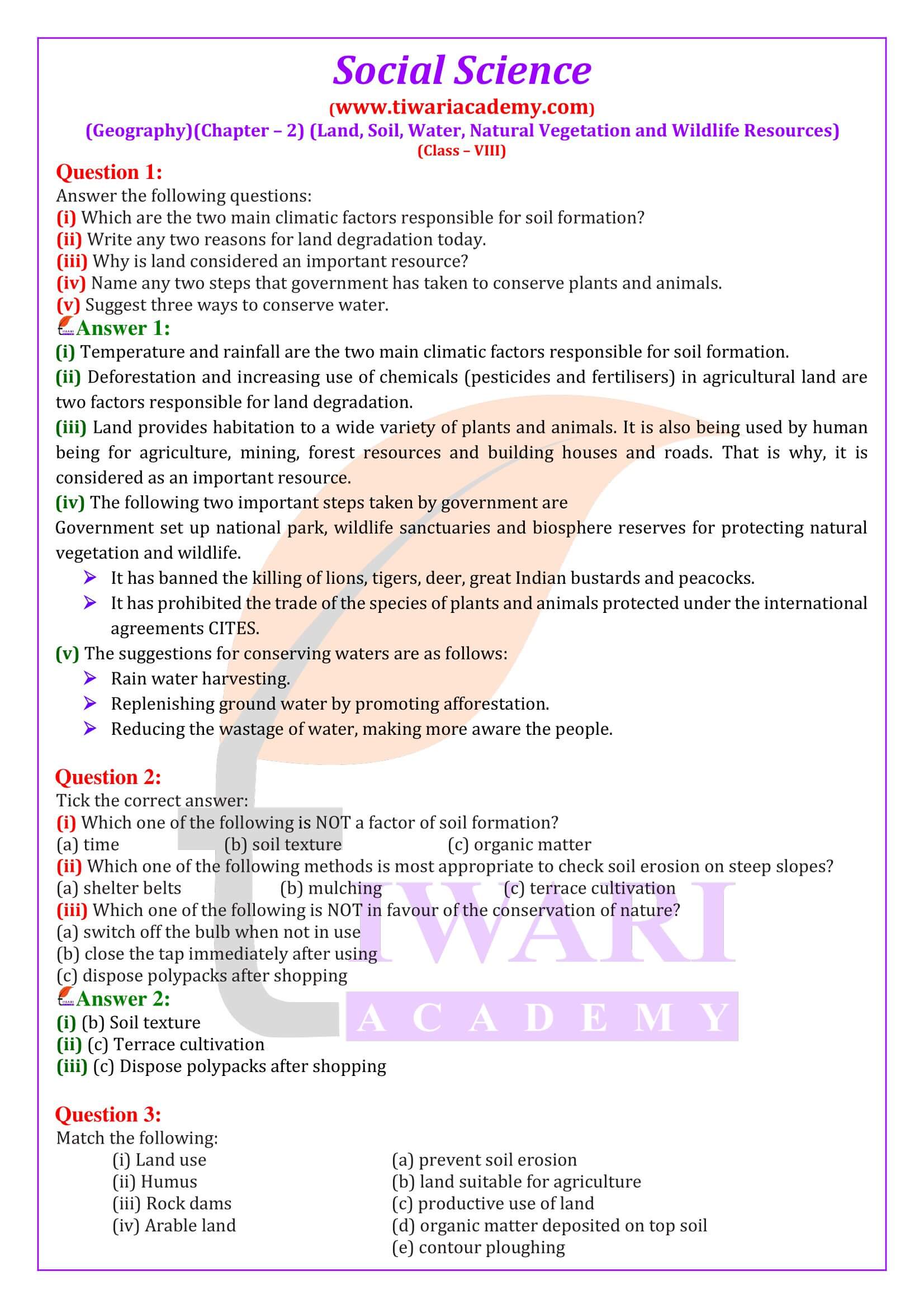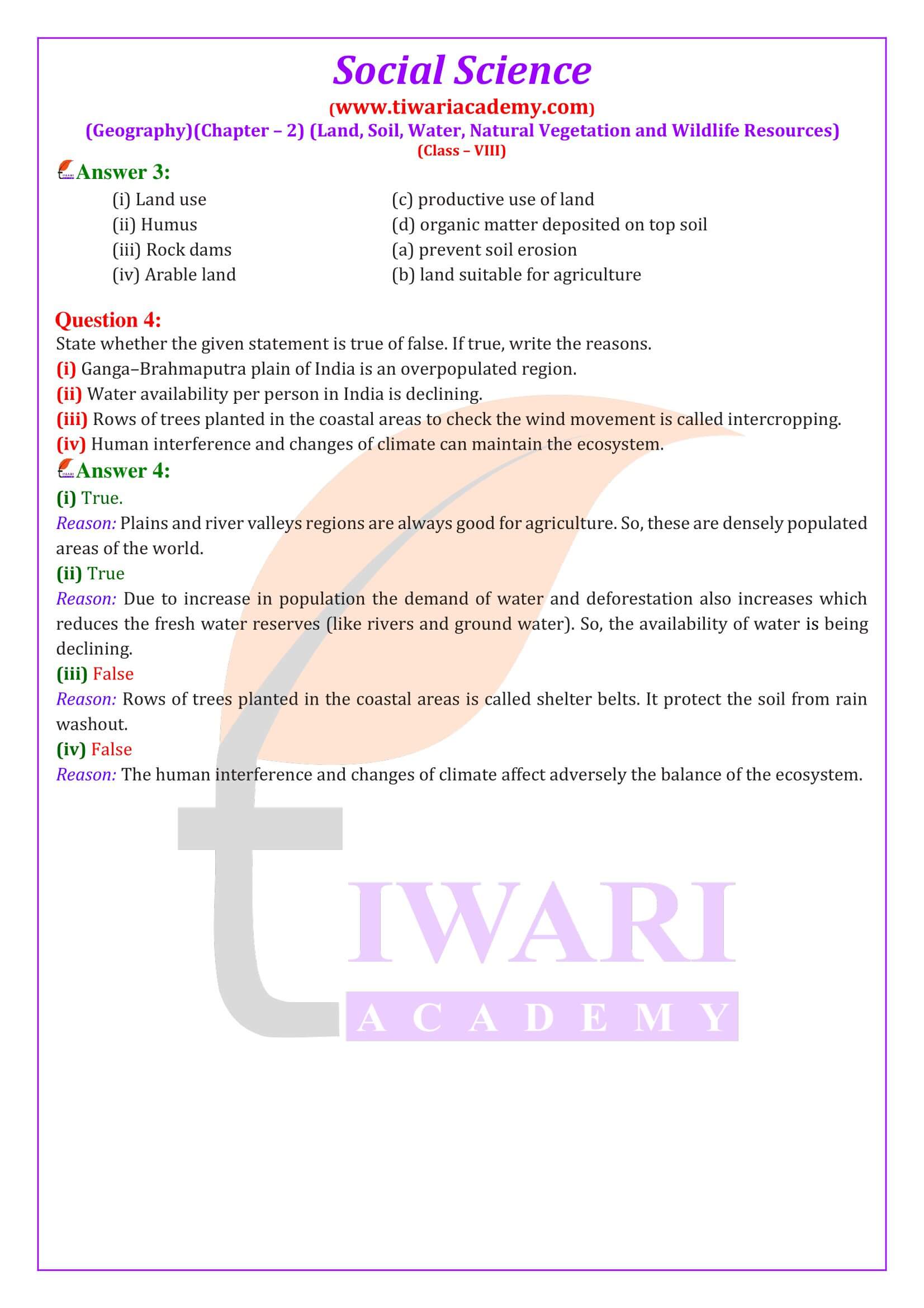NCERT Solutions for Class 8 Social Science Geography Chapter 2 Land, Soil, Water, Natural Vegetation and Wildlife Resources in Hindi and English Medium for session 2025-26. Class 8 Geography Chapter 2 Question Answers are revised and modified according to rationalised NCERT books published for academic year 2025-26.
NCERT Solutions for Class 8 Social Science Geography Chapter 2
| Class: 8 | Social Science |
| Subject: | Geography |
| Chapter 2: | Land, Soil, Water, Natural Vegetation and Wildlife Resources |
| Academic Session: | 2025-26 |
Class 8 Geography Chapter 2 extra Question
What do you mean by Land as a natural resource?
LAND: Land is among the most important natural resources. It covers only about thirty per cent of the total area of the earth’s surface and all parts of this small percentage are not habitable.
What are the uses of Land?
LAND USE: Land is used for different purposes such as agriculture, forestry, mining, building houses, roads and setting up of industries. This is commonly termed as Land use. Land can also be divided on the basis of private land and community land. Private land is owned by individuals whereas, community land is owned by the community for common uses like collection of fodder, fruits, nuts or medicinal herbs. These community lands are also called common property resources.
Why is soil considered as natural resource?
SOIL: Soil is made up of organic matter, minerals and weathered rocks found on the earth. This happens through the process of weathering. The right mix of minerals and organic matter make the soil fertile. The thin layer of grainy substance covering the surface of the earth is called soil. It is closely linked to land. Landforms determine the type of soil. The major factors of soil formation are the nature of the parent rock and climatic factors. Other factors are the topography, role of organic material and time taken for the composition of soil formation. All these differ from place to place.
Class 8 Geography Chapter 2 Question Answers
CBSE NCERT Solutions for Class 8 Social Science Geography Chapter 2 Land, Soil, Water, Natural Vegetation and Wildlife Resources is given below in updated form for session 2025-26. Download these solutions for offline use based on latest CBSE Syllabus 2025-26.
Important Questions on 8th Geography Chapter 2
Which are the two main climatic factors responsible for soil formation?
Temperature and rainfall are the two main climatic factors responsible for soil formation.
Write any two reasons for land degradation today.
Deforestation and increasing use of chemicals (pesticides and fertilisers) in agricultural land are two factors responsible for land degradation.
Why is land considered an important resource?
Land provides habitation to a wide variety of plants and animals. It is also being used by human being for agriculture, mining, forest resources and building houses and roads. That is why, it is considered as an important resource.
Name any two steps that government has taken to conserve plants and animals.
The following two important steps taken by government are Government set up national park, wildlife sanctuaries and biosphere reserves for protecting natural vegetation and wildlife. It has banned the killing of lions, tigers, deer, great Indian bustards and peacocks. It has prohibited the trade of the species of plants and animals protected under the international agreements CITES.
Suggest three ways to conserve water
The suggestions for conserving waters are as follows: Rain water harvesting. Replenishing ground water by promoting afforestation. Reducing the wastage of water, making more aware the people.
Which one of the following is NOT a factor of soil formation? (a) time (b) soil texture (c) organic matter
(b) soil texture
Which one of the following methods is most appropriate to check soil erosion on steep slopes? (a) shelter belts (b) mulching (c) terrace cultivation
(c) terrace cultivation
State whether the given statement is true of false. If true, write the reasons. Ganga–Brahmaputra plain of India is an overpopulated region.
True. Reason: Plains and river valleys regions are always good for agriculture. So, these are densely populated areas of the world.
State whether the given statement is true of false. If true, write the reasons. Water availability per person in India is declining.
True Reason: Due to increase in population the demand of water and deforestation also increases which reduces the fresh water reserves (like rivers and ground water). So, the availability of water is being declining.
State whether the given statement is true of false. If true, write the reasons. Rows of trees planted in the coastal areas to check the wind movement is called inter cropping.
False Reason: Rows of trees planted in the coastal areas is called shelter belts. It protect the soil from rain washout.
Important Notes on 8th Geography Chapter 2
Methods of soil conservation
1. Mulching: The bare ground between plants is covered with a layer of organic matter like straw. It helps to retain soil moisture.
2. Rock dam: Rocks are piled up to slow down the flow of water. This prevents gullies and further soil loss.
3. Contour barriers: Stones, grass, soil are used to build barriers along contours. Trenches are made in front of the barriers to collect water.
4. Contour ploughing: Ploughing parallel to the contours of a hill slope to form a natural barrier for water to flow down the slope.
5. Terrace farming: These are made on the steep slopes so that flat surfaces are available to grow crops. They can reduce surface run-off and soil erosion.
6. Intercropping: Different crops are grown in alternate rows and are sown at different times to protect the soil from rain wash.
7. Shelter belts: In the coastal and dry regions, rows of trees are planted to check the wind movement to protect soil cover.





